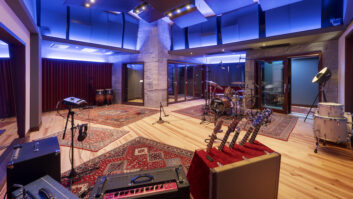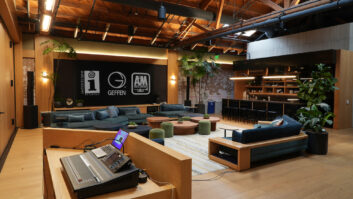Carlos Sotolongo has a Mickey Mouse job — literally. Over the years, he and his colleagues at The L.A. Studios have recorded Wayne Allwine and Russi Taylor (the voices of Mickey and Minnie) countless times, along with dozens of now-classic cartoon characters, voiced by actors and celebrity talents alike.
Recording voice-overs for animation requires a unique skill set. While voice-over mixers have to deal with mic selection and placement, compression and, of course, egos, just like music engineers, their relationships with talent and directors, and an understanding of the distinctive material being recorded places them in a singular category within the recording industry.
The L.A. Studios, located in the heart of Hollywood’s Cahuenga Pass, half-a-block from the former home of Hanna-Barbera Studios, opened its doors in 1980 to work with audio for commercials. “From day one, we were niche-focused on high-end spots,” explains company CEO Jesse Meli. “We started a film mixing business in one or two of the rooms, though we catered primarily to voice-related projects.” The film mixing business made its move to Hollywood proper 10 years later with the opening of Margarita Mix Hollywood, followed in 1999 with the opening of Margarita Mix de Santa Monica, a response to what Meli calls the “commercial diaspora” of advertising clients to L.A.’s West Side in the late 1990s.
While the Margarita Mix Studios also record voice-overs for a variety of markets, the Cahuenga facility focuses on recording voices for animated feature films and television series. The studio features a half-dozen rooms, each big enough to contain an ensemble of up to a dozen or so and each similarly outfitted. “The beauty of this facility is that the mixers can change rooms, as can the business markets,” Meli says.
Each room is set up with a Sony digital console running Pro Tools|MIXPlus (shortly transitioning to HD). All systems are networked in two ways: through enhanced Ethernet to a common server and through 110-ohm AES digital audio lines running throughout the building. Chief technical engineer Keith Scheyving designed the system to facilitate workflow and allow for scheduling flexibility. “On any given project, you can be working on dialog in one room and sound effects in another,” says Meli. “And all three of our facilities can speak to each other.” The suites are also digitally routed to a range of ISDN codecs, allowing for remote real-time recording with either talent or directors.
The rooms are also video-friendly, with tielines running from each room to the CMR. “Because of the DVD bonus features and commentary we record, edit and mix, in addition to our animation business, there’s quite a bit of videotaping going on on any given day,” says Meli. “This can be material for an EPK or Katie Couric when she recorded her part for Shark Tale. Our machine room is set up to record any choice of video format.”
While the facilities are state-of-the-art and client-friendly, it’s the mixers themselves, many of them part of the staff since the company opened, who keep the talent coming back. Mixers Sotolongo and Larry Winer have worked on weekly cartoon series and features such as the recent Shrek 2, Shark Tale and The SpongeBob Squarepants Movie, to name a few.
Recording for weekly animated series and features might appear to be similar, but they are quite different animals, notes Sotolongo. “The process for recording a feature can take three to four years, while a television show can record, perhaps, two episodes in one session,” he explains. Television sessions can involve recording an ensemble cast, while feature animation sessions typically involve recording a single actor at a time.
For a typical feature, the process usually begins with the recording of a “table read” by the whole cast, if possible, from which roughly drawn animatic sequences are created for a given scene. Once those are completed some months later, an actor will return to the studio to record the production track for the scene, on which final animation will be based. “They often videotape the actors during recording to capture their facial expressions, which is helpful for the animators,” explains Winer. The process continues over several years’ time, sometimes within months of release.
Celebrity actors sometimes need to become acclimated to working in animation. “They usually perform as if they are on a set,” Sotolongo says. “They are unaccustomed to the technical parameters typical to the VO process, such as not going off-mic, not turning one’s head or making noise or turning pages during a take.” That doesn’t appear to be a problem with TV animation. “We have the best actors here in Los Angeles,” he adds. “These guys are automatic. The read is already programmed into them, and they know how to work the mic.”
The engineers typically use Neumann U87s for feature recording, while television work gets a Gefell UMT 70S (both in-line with Millennia HV-3D preamps). “The Gefell is more midrangy, with less bottom or top end,” Sotolongo says. “It will cut through a television speaker much better than the Neumann.” Features are normally recorded at L.A. Studios with a pair of mics: one near and one far. “In features,” Sotolongo continues, “spatial environment is very important. The audio needs to match the scene. If it’s a big, wide shot of a big room, you’re not going to want a tight mic placement.” While animation recording receives compression, feature recording gets very little. “We want to leave it as dynamic as possible for the editor and the mixers down the line in post,” notes Winer.
During recording for TV, L.A. Studios provides a note-taker to keep track of take information, which becomes useful during editing. While feature recording characteristically results in complete session tapes being provided to the production, the mixers generally edit the recordings for television shows. “They’re quite fast,” says L.A. Studios general manager Jane Curry. “These shows usually have about 250 lines for a half-hour episode and they can edit approximately 30 to 35 lines per hour.” The editing is not as simple as one might expect. “On a lot of these shows, you’re cutting within words from different takes,” says Winer. “They can be very particular.”
Clients typically want to stay with one engineer once a project has started. “I think there’s an element of superstition coupled with a real trust factor involved,” says Curry. “The L.A. Studios specializes in delivering premium sound, and our clients appreciate the fact that we consistently deliver. They think, ‘Well, this previous project was very successful and Carlos did it, so we’d like Carlos for our new project.’ That’s why they get asked to travel. They’re aware that our guys know what their project needs and how it’s supposed to sound.”
“If there’s a fix that needs to take place or a pickup line that needs to be recorded and the director is tied up, they’re pretty confident that he doesn’t even need to show up,” adds Meli. “The director will have developed a rapport and a symbiosis with the mixer, where he’s confident the mixer can carry out his directive. That degree of faith is illustrated by our growing number of unattended sessions.”







